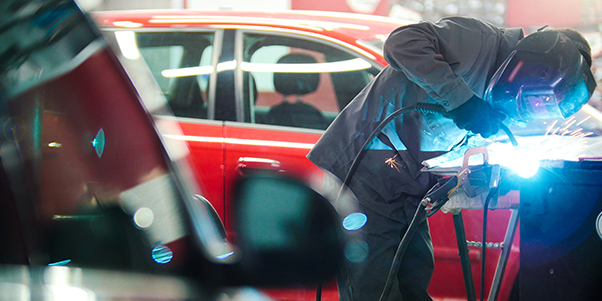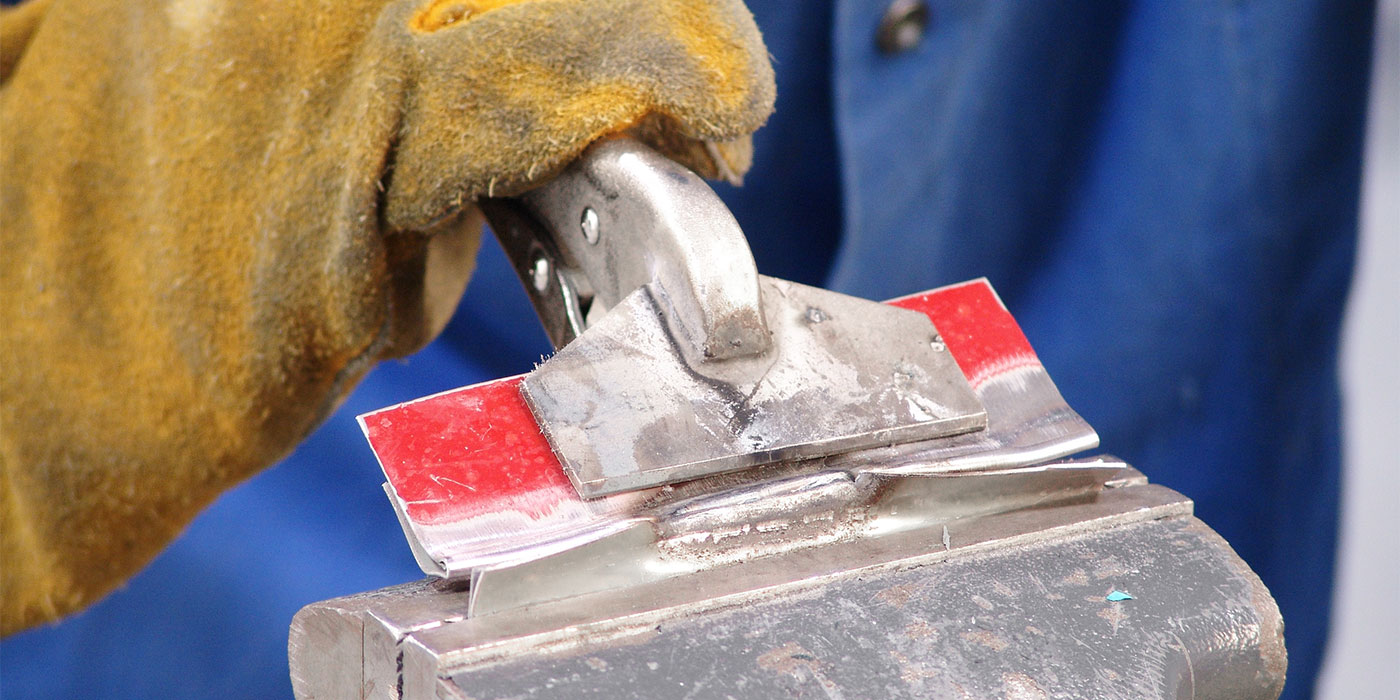
We all know vehicles are changing. But so are the ways we repair them. These changes have forced shops to re-evaluate the equipment they use to repair vehicles.
This re-evaluation brought forth the reality that we as an industry need better equipment with more capabilities. Nowhere in this industry has that been more noted than with the new welding requirements on today’s vehicles. For example, new heat-sensitive steels and aluminum-intensive vehicles. Weld bonding procedures, too, have changed the way we work. Having the correct equipment is no longer a luxury but a necessity.
Welding companies have stepped up their game in this environment. The welders we have available today are much more capable than the ones we had just five years ago. These new welders are changing repair processes in shops. They’ve also changed much more than “what” and “how” we weld as an industry.
Reality
There is nothing we do in the auto body repair industry that is more critical than welding. Whether it’s the weld itself, the spacing or pitch between welds, or the correct number in a given panel, all of these things must be done correctly. Every weld matters.
In the past (and honestly still today, from what I’ve seen), shops were using welding machines that should have been in the dumpster. They were too old, poorly maintained or just plain worn out. Shops do not replace the machines, and technicians use what’s available – “It’s the shop’s problem.” This creates a major problem in the industry because every time any shop puts out a poorly repaired vehicle, we all lose.
This is why training all technicians is a must for the entire industry. It doesn’t matter if you decide not to be a certified dealer shop. It also doesn’t matter if you don’t want to be an I-CAR Gold shop. The job must be done correctly for the safety of the families in the vehicles. Welding training especially is a must for all.
Change in Attitude (Morale Booster)
I learn a great deal about the industry as I travel across the country and do I-CAR welding qualifications. I see changes that occur in shops. I also see the frustration in technicians who struggle with subpar equipment. I will be honest with all shop owners and managers: If a shop does not have the right equipment and/or maintain it properly, the attitude in the shop is very much different than shops that have the proper equipment and have programs in place for all technicians to maintain that equipment.
Technicians know how they make their money. Any equipment or procedure that saves time and effort is a great asset to them. I’ve personally seen the morale in a shop go up after the shop purchases a new welding machine that has more capabilities and works correctly. Everyone’s attitude improves so much. Instead of struggling through the qualification test, they want to learn what the welder can do.
As an instructor, there’s nothing more disheartening than hearing a technician say, “This is all we have and let’s try to get this test done.” That technician will take that attitude right into the repair of the vehicle. When a new welder is being used, you see not just the technician testing but all of the technicians watching and wanting to learn more. That’s far different than, “Oh no, I have to do my I-CAR test!” Never assume that all technicians don’t want to learn to do better. I know some don’t; as an instructor, we still see those folks too. But most do.
For those who don’t see the value in shelling out big bucks for more capable welders, consider that it’s not just the weld quality that’s better; the attitude and morale also improves, which is priceless!
I-CAR
I-CAR has done a great job improving industry repair standards, especially with weld qualification testing. Shops and technicians are getting the training and the right tools for the right job. Technicians are used to seeing a new piece of equipment arrive and either not receive training or get bad training. This frustration damages our workforce. The I-CAR welding programs have made us all aware of the need for the proper equipment and repair procedures. Where would we be if I-CAR didn’t exist?
Training
I get this statement almost weekly: “Our welder sucks.” They may be referring to a new machine or old machine. Here’s my dilemma: Which one sucks – the machine or the person using the machine? I have to determine which welder is having the problem. Nine times out of 10, it comes down to training.
I hear, “Our welder sucks,” a lot when a shop gets a new welding machine. The new machine is usually fine; it’s the lack of training that’s the problem. Training should be almost as important if not just as important as selecting the machine.
Equipment Manufacturers
A problem I see in shops for technicians and myself is that instructions on these new machines are too vague. And some are too complicated. It takes a special breed of person who can get all they need to operate the machine from the instructions. Unless you have a good welding background, most instructions are worthless.
I know we expect technicians to know all the aspects of welding, terminology and techniques. And they will in time, and many do. But it’s a fact that going from a normal short-circuit machine to a pulse welder is different. If you haven’t seen or heard it, the process can be intimidating, if not frightening.
I urge you to make short videos and post them on your websites or YouTube. Still, I tell technicians to beware of what they see on the internet. I also tell them to visit the manufacturer’s website, as they can trust what they see there. It’s my opinion that many distributors do not do good training when the machine is delivered. They might on rare occasions, but I rarely hear anyone comment that it was good.
There is one welding manufacturer that has created a great website for learning. They produced a group of short, to-the-point videos on how to use and maintain their welders. Many are just short, two-minute videos that show certain procedures rather half-hour videos that show everything. This keeps the viewer’s attention and allows them to see or review something on their phone quickly while getting ready to weld. These videos also offer reminders or hints in case the technician forgot or just drew a blank on how to do something. They offer tremendous help on how to set up and maintain the equipment.
Vendors
Learn your machines! Know how to set them up and weld. You do not need to be perfect; you just need help to get you where you need to be.
I come into a shop and see a great welding machine. I ask first, “How do you like it? They respond, “We don’t use it that often because nobody showed us how to use it.” So a $10,000 machine sits in the corner gathering dust. I’ve seen squeeze-type resistance spot welders (STRSW) that have not been used in months. If you walk into a shop and see the equipment they purchased under a layer of dust, something is wrong!
From personal experience, I know that every I-CAR welding instructor has to educate themselves on every welder because they end up having to train on how to use the equipment correctly because some distributors aren’t doing that. Here’s a bold statement to distributors: If you just drop it off and leave, don’t sell it. I know I’ll get some flak for that. Technicians struggle enough, and time is precious. My plea to distributors is: Know how to use the machines and teach the shop. Set up time and be a resource. You’ll sell more equipment and earn a great reputation. Many shop owners comment, “I will never buy from them again. They did not help us in any way.” Follow through with shops.
Shops
You’re buying a piece of machinery that costs a lot of money. Do not just buy a machine – buy the service and training too. Having someone who can help in times of need, for example when you have a new technician or a machine gets damaged, is another priceless asset to a shop. Your money is hard-earned. Spend it wisely and research who will be there to follow through when you need them.
Whether it’s aluminum welders, STRSW machines or MIG/MAG steel welders, know which machine you need and what capabilities are required for today’s vehicles. If you haven’t purchased a STRSW machine, you’ll need to soon as it will become more critical to doing the job correctly. I know you will incur a serious cost for this machine, but I do not know how a shop will repair newer vehicles without it. Learn which machines are capable of welding new steels and have weld bonding capabilities.
Wire feed welders also need to have more capability such as pulse for aluminum and MIG brazing and welding with .030-diameter wires and not reach duty cycle so quickly. Learn what duty cycle is and how it affects the welds and the time to make welds.
NOTE: knowing how much the welder will be used is a key to which machine to buy. Many sell the multi-torch MIG/MAG welders, most of which are huge and bulky. If you truly need that and switching wire is a task you do not want to do, then a multi-torch is awesome. Many companies offer smaller versions with the same capabilities on just one torch. You have to switch out wire and torches in some cases, but many of these machines are considerably lower in cost than bigger machines. Many are the same size and are welders we’ve used for years, making them highly mobile. The size of the machine does not change its capability. You could buy two smaller-sized machines for the price of the bigger multi-torch systems.
Manufacturers
There are enough articles on welders and requirements to know what you need. Manufacturers have come a long way, and many features are becoming standard. I’ve had the opportunity to use many machines over the years, and some of them have had many dramatic improvements in capabilities.
STRSW
There are many good STRSW machines out there. Be aware that in some cases, vehicle manufacturers have specific power required for particular welds. Some require manual setting capability, and weld bonding or welding with adhesives must be considered. I see many older welding machines that are still in use. Be careful as sometimes, even though they make a weld, it may not be a correct weld to strength. The days of bulky, heavy heads that techs struggle to use and access hard-to-reach areas is changing. Also, be sure to check your shop for power and correct wiring for STRSW machines. The best machines will fail if not enough power or inconsistent power is an issue.
MIG/MAG Welders
There are so many new and awesome MIG/MAG welders I’ve gotten to try while doing I-CAR welding qualifications. Many having multi-functions on each machine. No longer is a welder just for steel welding only.
Summary
There are so many good welding machines out there. But a machine has zero value without the training and service to back it up. The value of a machine is not in what it costs your shop but what it brings to your shop as far as capabilities and ability to boost morale.
So, if your welder is not performing, what’s the problem: the machine or the person using it? Both are easily remedied. B













